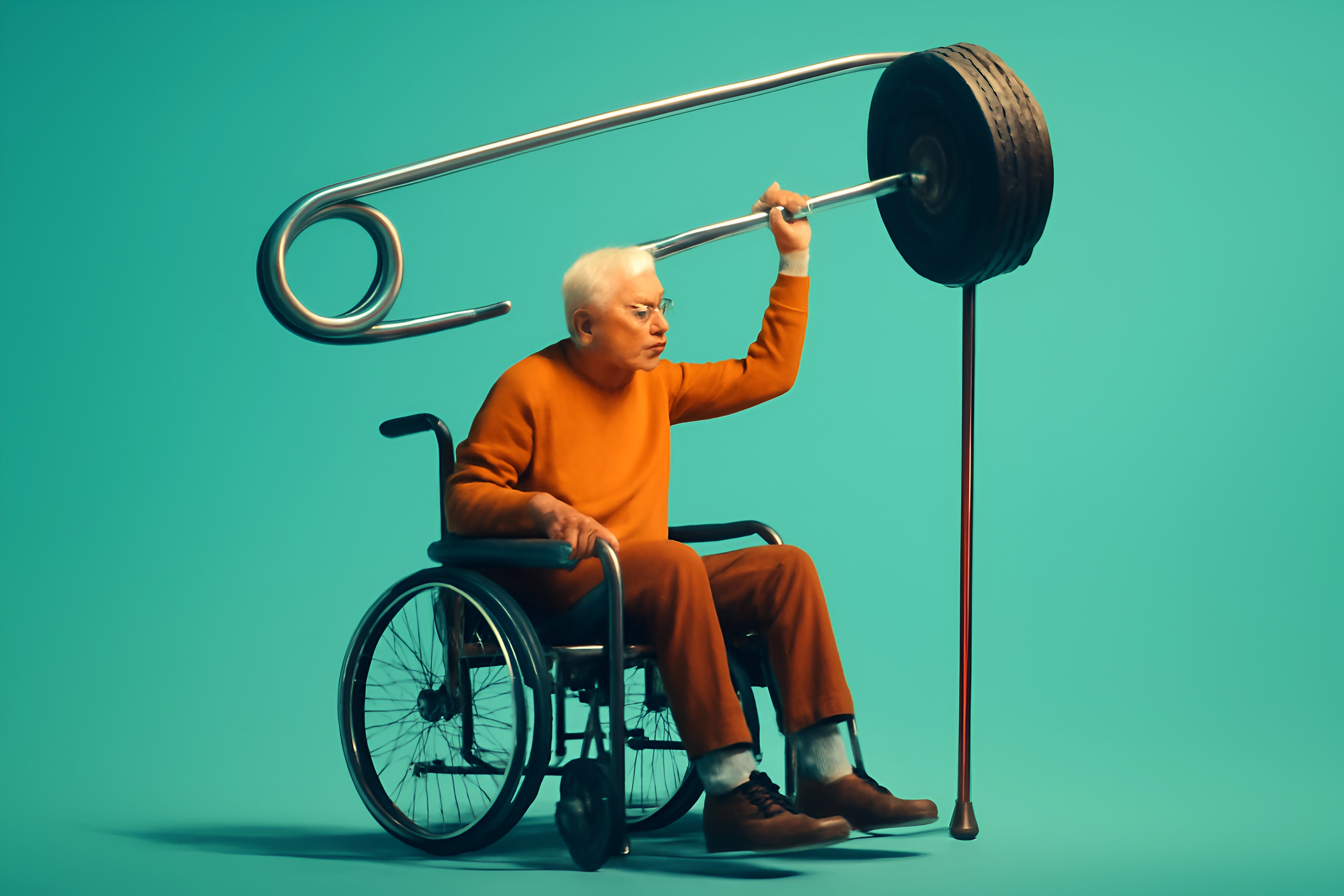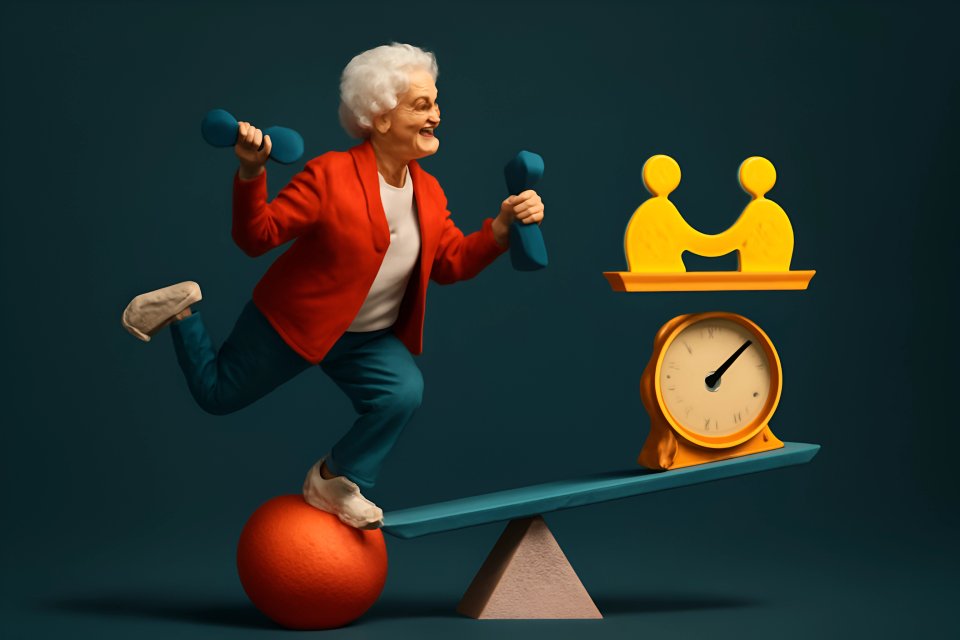
Feeling like your body is holding you back? It’s a frustrating, isolating feeling when simple movements become daily hurdles. But limited mobility doesn't have to mean a limited life. In fact, building strength is one of the most powerful tools you have to reclaim your confidence and stay independent for years to come.
This isn't about impossible fitness goals or punishing workouts. This is about rediscovering the power that already lies within you. We're here to demystify strength training for older adults and show you simple, safe, and effective exercise modifications you can do right from the comfort of your home.
Forget what you think you know about lifting weights. It's time to learn how to work with your body, not against it, to build a foundation of strength that supports the life you want to live.
Why Strength Training is Non-Negotiable, Even with Limited Mobility
Why bother with strength training when just getting around is a challenge? Because your very independence depends on it. Every time you push yourself up from your favorite armchair, carry a bag of groceries from the car, or bend down to hug a grandchild, you are using your strength. When that strength fades, so does your freedom.
The benefits are not abstract; they are woven into the fabric of your daily life. Consistent strength work dramatically improves your balance and stability, which is your number one defense against life-altering falls. Research shows that tailored exercise programs, including resistance training, can significantly reduce mobility limitations in older adults and delay the onset of disability. It’s about having the power to navigate your world with confidence.
At FitOverFifty, we believe fitness is about enhancing your quality of life, not chasing an unrealistic ideal. This is about building functional strength that serves you every single day. It boosts your metabolism, gives you more energy, and even helps fight osteoporosis by increasing bone density, ensuring you remain a vibrant, active participant in your own life.
Before You Begin: Your Safety Checklist
Before you move a single muscle, let's talk about the golden rule. Your safety is the absolute priority, and smart preparation is the key to success. This is your non-negotiable first step.
The most important thing you can do is this: Consult your doctor or a physical therapist before starting any new exercise program. This is especially critical if you live with chronic conditions like heart disease or arthritis, experience persistent pain, or are recovering from a recent injury or surgery. They can provide personalized advice to ensure you get all the benefits without the risks.
Once you have the green light, keep these key safety principles in mind. Think of this as your personal code of conduct for every workout. Studies confirm that strength training has minimal adverse effects when properly supervised and executed, so following these rules is your path to powerful results.
- Listen to Your Body: The "no pain, no gain" mantra is dangerous and does not apply here. You should feel your muscles working, but you should never feel sharp, stabbing, or joint pain.
- Start Low, Go Slow: Begin with no weight or very light resistance. Focus on completing a few quality repetitions rather than pushing for a high number. Consistency over time is what builds true strength.
- Focus on Form: Proper technique is everything. It prevents injury and ensures you are targeting the correct muscles for maximum benefit. It's better to do one perfect repetition than ten sloppy ones.
- Breathe! It's a natural tendency to hold your breath when you exert yourself, but don't. A good rule of thumb is to exhale on the hardest part of the movement (the "effort") and inhale as you return to the start.
- Stay Hydrated: Keep a glass of water nearby and sip it before, during, and after your session to keep your muscles and joints happy.
Your Toolkit for Adaptive Strength Training
Think of exercise modification not as "cheating," but as smart training. It’s the secret to unlocking consistent progress without risking injury or burnout. By adapting exercises to fit your current ability, you ensure that you can keep showing up, and consistency is what ultimately creates change.
These principles are your toolkit. You can apply them to almost any strength exercise to make it work for you, right now. The National Institute on Aging provides excellent guidelines on strength training for older adults that emphasize this adaptive approach.
Mastering these simple adjustments empowers you to take control of your fitness journey, turning frustration into a feeling of accomplishment.
Change Your Position (Sit Down!)
The chair is your best friend and your greatest tool for safe strength training. Nearly any exercise that is traditionally done standing—from bicep curls to overhead presses—can be performed safely and effectively from a sturdy, armless chair. This provides a stable base of support, reduces the demand on your balance, and allows you to focus purely on strengthening the target muscles without fear of falling.
Reduce Your Range of Motion
You do not need to perform a deep, floor-touching squat to build powerful legs. A small, controlled bend in the knees is still incredibly effective at activating your quadriceps and glutes. The goal is to move within a range that is comfortable and pain-free. As you get stronger and more flexible, your range of motion will naturally increase.
Use Support
Never hesitate to use a wall, a countertop, or the back of a sturdy chair for balance and support. Placing a hand on a stable surface during exercises like leg lifts or calf raises gives you the confidence to execute the movement with proper form. This isn't a crutch; it's a smart tool that allows you to safely challenge your muscles while your stability improves over time.
Adjust the Resistance
The most accessible tool for resistance training is your own body. Bodyweight exercises are the perfect starting point. As you progress, you can introduce light resistance with inexpensive tools like resistance bands, small dumbbells, or even common household items like soup cans or water bottles. The key is to add resistance so gradually that you barely notice the change, allowing your muscles to adapt and grow stronger.
Safe Workout Modifications You Can Do Today
Ready to put this into practice? Here are some of the most effective strength exercises, broken down with simple modifications you can start using immediately. Remember, the goal is to find the version that feels challenging but safe for you. The Mayo Clinic offers excellent advice on adapting strength training exercises for seniors to ensure you get the most out of every movement.
Even small changes, like focusing on controlled speed during a lift, can lead to modest improvements in physical function, so pay attention to how you move.
Lower Body (Your Stability Muscles)
- Exercise: The Squat
Modification 1 (Seated): The Chair Squat is the gold standard. Sit tall at the edge of a sturdy, armless chair with your feet flat on the floor. Without using your hands, press through your heels to stand up completely, then slowly lower yourself back down with control.
Modification 2 (Supported): Try a Wall Sit. Stand with your back against a wall and walk your feet out. Slowly slide your back down the wall until your knees are slightly bent, as if sitting in a high chair. Hold for 10-30 seconds.
- Exercise: Leg Extensions
Modification 1 (Seated): This is a fantastic quad-strengthener. Sit tall in a chair and hold on to the sides for support. Slowly extend one leg straight out in front of you, squeezing the thigh muscle. Hold for a moment before slowly lowering it back down.
Upper Body (For Lifting and Pushing)
- Exercise: The Push-Up
Modification 1 (Supported): Wall Push-Ups are a perfect starting point. Stand facing a wall, about arm's length away. Place your palms flat on the wall, slightly wider than your shoulders. Slowly bend your elbows and lean your body toward the wall, then press back to the starting position.
Modification 2 (Elevated): As you get stronger, move to a sturdy countertop or the back of a sofa. The lower the surface, the more challenging the exercise becomes.
- Exercise: The Row
Modification 1 (Seated): Seated Resistance Band Rows build crucial back strength for better posture. While seated, loop a resistance band around the soles of your feet. Sit up tall, grab the ends of the band, and pull your elbows straight back, squeezing your shoulder blades together.
Core (Your Center of Balance)
- Exercise: The Crunch
Modification 1 (Seated): Try Seated Abdominal Bracing. Sit tall in your chair, feet flat on the floor. Take a deep breath in, and as you exhale, tighten your abdominal muscles as if you were about to be punched in the stomach. Hold the contraction for 5-10 seconds while continuing to breathe normally.
Modification 2 (Lying Down): Pelvic Tilts are gentle yet effective. Lie on your back with your knees bent and feet flat on the floor. Gently press your lower back into the floor by tightening your core and tilting your pelvis upward slightly.
Your 15-Minute Gentle Strength Circuit
Now, let's put it all together. A circuit means you perform one exercise after another with very little rest in between. This keeps your heart rate up and makes for a very efficient workout. Aim for 8-12 repetitions of each exercise, and complete the full circuit 1-2 times through.
| Phase | Exercise | Reps/Duration | Notes |
|---|---|---|---|
| Warm-up | Seated Marching | 2 minutes | Lift knees gently, swing arms. |
| Warm-up | Arm Circles | 30 seconds | Small circles forward, then backward. |
| Circuit | Chair Squats | 8-12 reps | Use hands for support only if needed. |
| Circuit | Seated Resistance Band Rows | 8-12 reps | Squeeze shoulder blades together. |
| Circuit | Seated Leg Lifts | 8-12 reps/leg | Alternate legs after each set. |
| Circuit | Wall Push-Ups | 8-12 reps | Keep your core tight. |
| Circuit | Seated Abdominal Bracing | 5 holds | Hold each contraction for 10 seconds. |
| Cool-down | Gentle Stretches | 3-5 minutes | Stretch your arms, legs, and back gently. |
Your Questions About Strength Training with Limited Mobility, Answered
It's natural to have questions when starting something new. Here are answers to some of the most common concerns we hear from the FitOverFifty community.
How often should a senior with mobility issues do strength training?
The goal is consistency, not exhaustion. For most older adults, aiming for 2-3 strength training sessions per week on non-consecutive days is the sweet spot. This schedule provides enough stimulus to build muscle and gives your body adequate time to recover and repair, which is when the real magic happens. Leading organizations provide evidence-based recommendations for resistance training that support this frequency for optimal health benefits.
Can you still build muscle after 60 or 70?
Absolutely, yes! It is a myth that muscle building is only for the young. While age-related muscle loss, known as sarcopenia, is a real phenomenon, strength training is the single most effective way to combat age-related muscle loss and even reverse it. Your muscles are incredibly adaptable and are ready to grow stronger at any age, provided you give them the right challenge.
What if I feel sore the next day?
It's important to distinguish between two types of feelings. Mild muscle soreness or stiffness, often called Delayed Onset Muscle Soreness (DOMS), is a normal sign that your muscles have been challenged and are now rebuilding themselves stronger. However, sharp, stabbing, or persistent pain in your joints is a red flag. If you feel good soreness, gentle movement like walking, light stretching, and staying hydrated can help. If you feel actual pain, stop the exercise that's causing it and consult your doctor or physical therapist.
Conclusion: Every Movement is a Victory
Strength training isn't about becoming a bodybuilder; it's about becoming the strongest, most capable version of yourself. It is accessible, it is adaptable, and it is absolutely essential for protecting your independence and vitality. By embracing modifications and listening to your body, you can build the strength you need to live life on your own terms.
Remember, the goal isn't perfection—it's progress. Celebrate every repetition and every small gain in strength, whether it's standing up from a chair with a little more ease or carrying your groceries with more confidence. You are capable, you are strong, and you are taking control of your health, one movement at a time.
What's your favorite modification or a small win you've had with strength training? Share with the FitOverFifty community in the comments below















